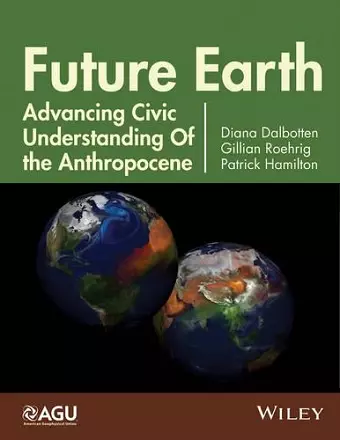Future Earth
Advancing Civic Understanding of the Anthropocene
Patrick Hamilton author Diana Dalbotten author Gillian Roehrig author
Format:Hardback
Publisher:John Wiley & Sons Inc
Published:20th Jun '14
Currently unavailable, and unfortunately no date known when it will be back

Earth now is dominated by both biogeophysical and anthropogenic processes, as represented in these two images from a simulation of aerosols. Dust (red) from the Sahara sweeps west across the Atlantic Ocean. Sea salt (blue) rises into the atmosphere from winds over the North Atlantic and from a tropical cyclone in the Indian Ocean. Organic and black carbon (green) from biomass burning is notable over the Amazon and Southeast Asia. Plumes of sulfate (white) from fossil fuel burning are particularly prominent over northeastern North America and East Asia. If present trends of dust emissions and fossil fuel burning continues in what we call the Anthropocene epoch, then we could experience high atmospheric CO2 levels leading to unusual warming rarely experienced in Earth's history. This book focuses on human influences on land, ocean, and the atmosphere, to determine if human activities are operating within or beyond the safe zones of our planet's biological, chemical, and physical systems.
Volume highlights include:
- Assessment of civic understanding of Earth and its future
- Understanding the role of undergraduate geoscience research and community-driven research on the Anthropocene
- Effective communication of science to a broader audience that would include the public, the K-12 science community, or populations underrepresented in the sciences
- Public outreach on climate education, geoscience alliance, and scientific reasoning
Future Earth is a valuable practical guide for scientists from all disciplines including geoscientists, museum curators, science educators, and public policy makers.
“The book concludes with an important chapter on the division between the media/journalism and science. Each chapter includes references and a limited number of graphs and maps. Comprehensive ten-page index. Summing Up: Recommended. All general, academic, and professional library collections.” (Choice, 1 January 2015)
"Although this work is intended primarily for an American audience – with many practical examples, from wild rice cultivation in wetlands to the potential for informal science education in museums and zoos -and should be compulsory lecture for scientists dealing with societal challenges in an American context, it contains many concepts and approaches that are globally useful.” (Geologica Belgica, 17 March 2014)
ISBN: 9781118854303
Dimensions: 286mm x 220mm x 13mm
Weight: 617g
144 pages